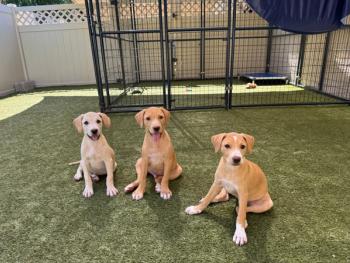
How smart is your dog?
British Columbia -- Dogs' mental abilities are equivalent to a 2- or 2.5-year-old child, according to psychologist and canine researcher Stanley Coren, PhD, of the University of British Columbia.
British Columbia
-- Dogs' mental abilities are equivalent to a 2- or 2.5-year-old child, according to psychologist and canine researcher Stanley Coren, PhD, of the University of British Columbia.
The author of numerous books on dogs, including The Modern Dog and The Pawprints of History: Dogs and the Course of Human Events, presented his findings at the American Psychologists Association's 117th annual convention Aug. 8.
In an interview with DVM Newsmagazine, Coren explained that he adapted communication tests used for nonverbal children. He found the average dog understands 165 words, gestures, signs and signals. The most intelligent breeds understand up to 200 or 250. "Over 15,000 years or more, humans have been systematically modifying dogs so they're better at understanding us," he says. "If I point at something, a dog will look at what I'm pointing at. A wolf raised in the wild who sees me point will look at my hand."
Coren also used data from more than 200 dog-obedience judges to figure the relative intelligence of different breeds, developing a top-seven list. Border Collies came first, followed by Poodles, German Shepherds, Golden Retrievers, Dobermans, Shetland Sheepdogs and Labrador Retrievers.
Scientists have realized that consciousness is not an "on-off switch," Coren says, and that dogs fall on a continuum of sentience with humans and other animals. This understanding benefits future researchers who won't be studying blind. "Psychologists interested in the emotions of dogs can ask, what emotions does a 2-year-old have? Fear, anger, happiness, surprise, but not complex emotions like guilt," he says.
Some of dogs' developed abilities cater especially to humanity's hunting interests, Coren says. With the start of the Ice Age, large prey were scarcer, and hunters found themselves needing to use bow and arrow to catch smaller animals. Dogs were invaluable in finding, catching and retrieving wounded prey. At first, hounds sniffed out prey for hunters without long-distance weapons. With the development of the slow-reloading musket, hunters used setters to quietly find, point at prey and freeze for a close shot. Later, setters were used in pairs to improve trajectory from a distance.
When hunting rifles really improved, relatively undisciplined spaniels were sent into fields and marshes to frighten birds into flight and into range. Today, Coren says, one of the best dogs for hunters with multiple-shot shotguns is the Nova Scotia Duck-tolling Retriever. It bounds up and down the edges of a lake or field, acting erratically. Birds will move to get a view of the dog's crazy movements, putting them in the hunter's sights.
The future of dog breeding, however, will lie more in the world of companion animals, Coren says. Breeds like the Coton de Tulear are "little pieces of empathy. That dog resting on a sofa makes a whole lot of friends," he says. Future research into the health benefits of owning dogs will be Coren's focus. "We know that elderly or socially isolated people with dogs need less medical services and live longer," he says. "Dogs are going to have a newer niche there."
Newsletter
From exam room tips to practice management insights, get trusted veterinary news delivered straight to your inbox—subscribe to dvm360.






